-
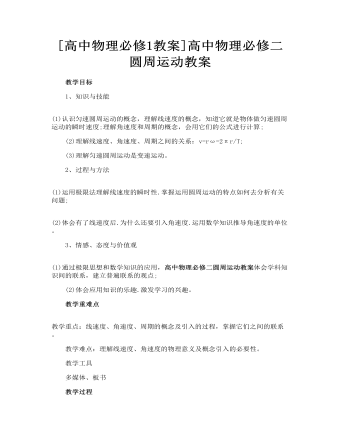
高中物理必修二圆周运动教案
1、知识与技能 (1)认识匀速圆周运动的概念,理解线速度的概念,知道它就是物体做匀速圆周运动的瞬时速度;理解角速度和周期的概念,会用它们的公式进行计算; (2)理解线速度、角速度、周期之间的关系:v=rω=2πr/T; (3)理解匀速圆周运动是变速运动。 2、过程与方法 (1)运用极限法理解线速度的瞬时性.掌握运用圆周运动的特点如何去分析有关问题; (2)体会有了线速度后.为什么还要引入角速度.运用数学知识推导角速度的单位。
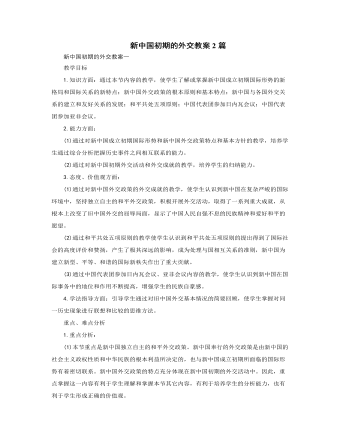
人教版高中历史必修1新中国初期的外交教案2篇
展示幻灯片17、19——21视频18,了解与中国建交的17个国家的概况,说明这是新中国成立后外交上取得的首次突破。 第一个和中国建交的非社会主义国家印度继承了英帝国主义在中国的特权,建国后中印双方多次就西藏问题进行谈判,正是在这一过程中周总理创造性地提出了和平共处五项原则。 成就2和平共处五项原则的提出 展示幻灯片22、23及视频24 探究:和平共处五项原则形成的过程是怎样的?内容是什么?有何意义? 结论(一)三个提出过程,强调重点是首次提出 (二)内容及其修订 (三)意义:标志着新中国外交的成熟;它为开创中国外交新局面奠定了基础;在世界上也产生深远的影响,成为解决国与国之间问题的基本准则。 展示幻灯片25、26 问题情境3:三、步入世界外交舞台
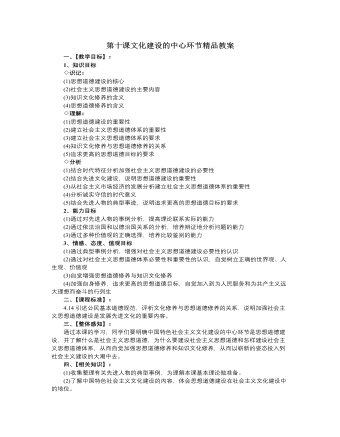
人教版高中政治必修3第十课文化建设的中心环节精品教案
1、追求更高的思想道德目标的要求(1)在遵守公民基本道德规范的基础上,追求更高的思想道德目标,是一个不断改造主观世界的长期过程。积极的、健康的、进步的思想道德,总是旧消极的、有害的、落后的思想道德相比较而存存、相斗争而发展的。只有形成正确的世界观、人生观、价值观,真正划清唯物论与唯心论的界限,社会主义心想与封建主义、资本主义腐朽思想的界限,科学与迷信的界限,文明与愚昧的界限、才能切实增强识别和抵制各种错误思潮的能力,为此,必须努力学习马克思主义的科学理论,坚定建没小闻特色社会主义共同理想,逐步树立共产主义远大理想。◇点拨:“专家点评”说明了共同理想与最高理想的关系。(1)共同理想和最高理想的区别:含义不同。根据马克思主义的科学预见,共产主义社会将是物质财富极大丰富、人民精神境界极大提高,每个人自由而全面发展的社会。
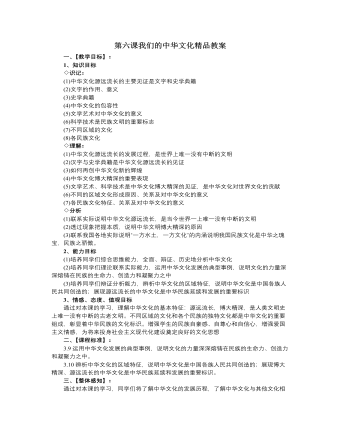
人教版高中政治必修3第六课我们的中华文化精品教案
(三)、中华之瑰宝.民族之骄傲1.我国各具特色的民族文化异彩纷呈.都为中华文化的形成和发展做出了重要贡献(1)我国的雕刎建筑艺术是各族人民共同创造的,都是中华文化的瑰宝。例如:敦煌石窟、云冈石窟;克孜尔千佛洞等,是古代的汉族、鲜卑以及西域各族的艺术家和劳动人民共同创造的。(2)许多少数民族用自己的语言文字创造了优秀的民族文学。例如:藏族的《格萨尔王传》、蒙古族的《江格尔》和柯尔克孜族的《玛纳斯》被并为三大英雄史诗。◇注意:民族文化深深地体现着各民族的风俗和精神面貌,通过一定的物质展现,可以表现在建筑、民族文学、舞蹈、习俗、信仰、衣着等方方面面。◇点拨:“相关链接”中提到的《江格尔)是蒙古族卫拉特郝英雄史诗。史诗的篇幸结构、故事情节、语言风格等具有蒙古族说唱艺术的特点。从民族文学角度反映了本民族的文化生活.同时也为中华文化增添了绚丽色彩。◇课堂探究:(1)你还知道哪蝗少数民族舞蹈?它们务有什么特点?
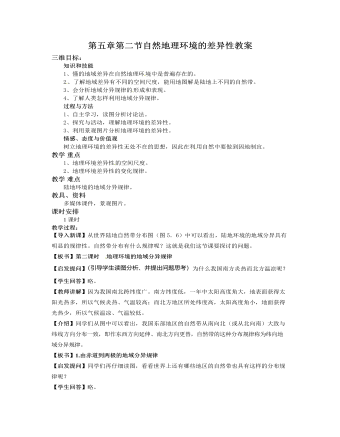
人教版高中地理必修1第五章第二节自然地理环境的差异性教案
【补充说明】我们这节课简要地分析了陆地环境的三种地域分异规律。实际上,世界上的任何事物有其一般性,也有它的特 殊性。在地带性分异规律的基础上,陆地环境因为受到海陆分布、地形 起伏等因素的影响,也会出现一些不规律的现象,这种现象称为非地带性。例如,我们在初中地理中学过绿洲。还记得什么叫绿洲吗?再比如,在南美洲的西海岸(太平洋沿岸),有一条狭长的(热带)荒漠带,而缺少热带草原带,热带雨林带主要是分布在赤道以北地区。这主要是受大的地形起伏的影响。因为南美洲西部是一列高大的安第斯山脉,受其影响,两边的气候状况不同,所以就出现了分布规律不同的自然带,这也是一种非地带性现象。【总结】有规律分布的自然带构成了全球和谐的自然环境整体。自然带之间错综复杂的、微妙的要素关系,有许多是人类还没有认识到的。因此,人类不能随意去破坏任何哪怕是极微小的环节,也许它 带来的影响会是全球性的。保护全球环境,人人有责。
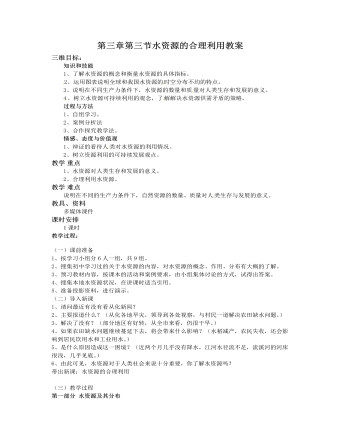
人教版高中地理必修1第三章第三节水资源的合理利用教案
5、请列举开源的措施。(包括合理开发和提取地下水;修筑水库;开渠引水实行跨流域调水;海水淡化;人工增雨等。6、开源“五水”歌:开发地下水、蓄积洪水,跨流域调水,淡水海水,人增雨水。能马上背出来吗?7、请列举节流的措施。(包括加强宣传教育,提高公民节水意识;重视改进农业灌溉技术,提高工业用水的重复利用率等。)8、水资源时刻影响着我们的生存和发展,尽管我们已经学习了关于如何合理利用水资源的知识,但关键还是要研究问题和解决问题,面对复杂的生活环境,具体问题要具体分析,看课本70页“活动”,请小组派代表回答问题。提示:(1)西北地区的水资源供给,从可持续发展的角度,解决水资源的供求矛盾应体现在:控制人口数量,减少用水规模;发展节水农业;保护生态环境,退耕还林还草。(2)我国缺水问题,谈谈看法:通过电视、报纸杂志、互联网收集有关水资源的资料;确定综合思维、立体思维的方法,全面多角度地寻找解决缺水的对策。
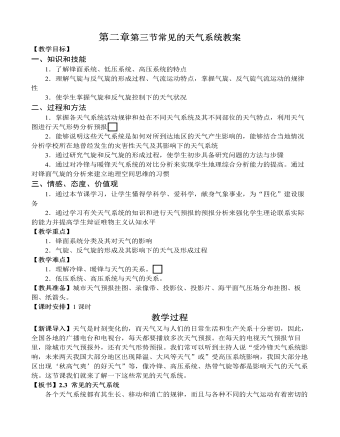
人教版高中地理必修1第二章第三节常见的天气系统教案
一、知识和技能1.了解锋面系统、低压系统、高压系统的特点2.理解气旋与反气旋的形成过程、气流运动特点,掌握气旋、反气旋气流运动的规律性3.使学生掌握气旋和反气旋控制下的天气状况二、过程和方法1.掌握各天气系统活动规律和处在不同天气系统及其不同部位的天气特点,利用天气图进行天气形势分析预报2.能够说明这些天气系统是如何对所到达地区的天气产生影响的,能够结合当地情况分析学校所在地曾经发生的灾害性天气及其影响下的天气系统3.通过研究气旋和反气旋的形成过程,使学生初步具备研究问题的方法与步骤4.通过对冷锋与暖锋天气系统的对比分析来实现学生地理综合分析能力的提高。通过对锋面气旋的分析来建立地理空间思维的习惯三、情感、态度、价值观1.通过本节课学习,让学生懂得学科学、爱科学,献身气象事业,为“四化”建设服务
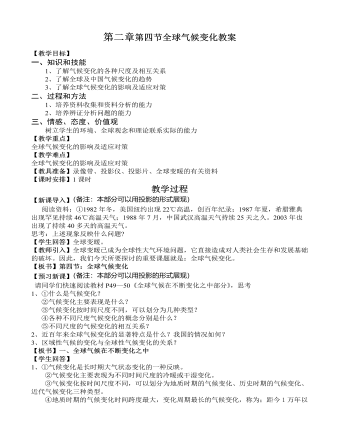
人教版高中地理必修1第二章第四节全球气候变化教案
气候变化对健康的影响 气候变化对人体健康的不良影响是不难发现的:热浪冲击频繁加重可致死亡率及某些疾病、特别是心脏呼吸系统疾病发病率增加;对气候变化敏感的传染性疾病如疟疾和登革热的传播范围可能增加。极端气候事件, 如干旱、水灾、暴风雨等, 使死亡率、伤残率及传染病疾病率上升, 并增加社会心理压力。某些媒介疾病的加重也可能与气候变化有间接的关系, 如疟疾是通过蚊子传播的疾病,气候变化可能使某些变暖地区的蚊子数目增加, 从而加重了疟疾的发生。我国1994年疟疾的发病率为5.3408/10万, 居全国法定传染病的第六位。血吸虫病的发展与高温及灌溉系统的扩增有关。我国1994年南方12省市血吸虫病患者的检出率高达3.67%,不能忽视气候变化对此的可能影响。还有一些疾病,如睡眠病、登革热、黑热病等也有与气候关系的报道。另外, CO2、一些空气污染物如氮氧化物、臭氧等可增加过敏疾患及心脏呼吸系统疾病和死亡。
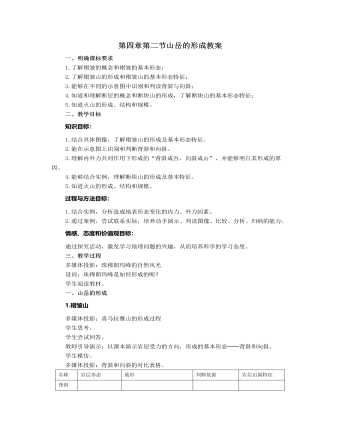
人教版高中地理必修1第四章第二节山岳的形成教案
一、明确课标要求1.了解褶皱的概念和褶皱的基本形态;2.了解褶皱山的形成和褶皱山的基本形态特征;3.能够在不同的示意图中识别和判读背斜与向斜;4.知道和理解断层的概念和断块山的形成,了解断块山的基本形态特征;5.知道火山的形成、结构和规模。二、教学目标知识目标:1.结合具体图像,了解褶皱山的形成及基本形态特征。2.能在示意图上识别和判断背斜和向斜。3.理解内外力共同作用下形成的“背斜成谷,向斜成山”,并能够明白其形成的原因。4.能够结合实例,理解断块山的形成及基本特征。5.知道火山的形成、结构和规模。过程与方法目标:1.结合实例,分析造成地表形态变化的内力、外力因素。2.通过案例,尝试联系实际,培养动手演示、判读图像、比较、分析、归纳的能力。
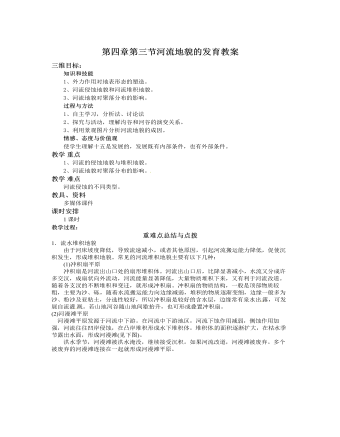
人教版高中地理必修1第四章第三节河流地貌的发育教案
1.流水堆积地貌由于河床坡度降低,导致流速减小 ,或者其他原因,引起河流搬运能力降低,促使沉积发生,形成堆积地貌。常见的河流堆积地貌主要有以下几种:(1)冲积扇平原冲积扇是河流出山口处的扇形堆积体。河流出 山口后,比降显著减小,水流又分成许多交汉,成扇状向外流动,河流能量显著降低,大量物质堆积下来,又有利于河流改道。随着各支汊的不断堆积和变迁,就形成冲积扇。冲积扇的物质结构,一般是顶部物质较粗,主要为沙、砾 ,随着水流搬运能力向边缘减弱,堆积的物质逐渐变细,边缘一般多为沙、粉沙及亚粘土,分选性较好,所以冲积扇是较好的含水层,边缘常有泉水出 露,可发展自流灌 溉。若山地河谷随山地间歇抬升,也可形成叠置冲积扇。(2)河漫滩平原河漫滩平原发源于河流中下游。在河流中下游地区,河流下蚀作用减弱,侧蚀作用加强,河流往往凹岸侵蚀,在凸岸堆积形成水下堆积体。堆积体 的面积逐渐扩大,在枯水季节露出水面,形成河漫滩(见下图)。
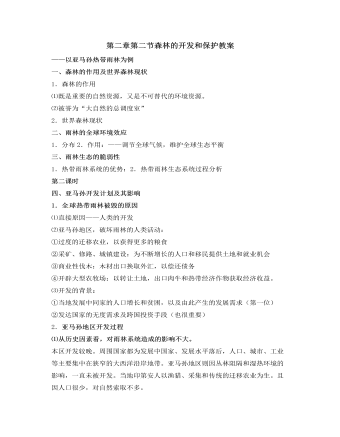
人教版高中地理必修3第二章第二节森林的开发和保护教案
活动建议:亚马孙雨林的开发和保护,一直作为一个两难问题困扰着决策者们。这三个议题的提出,为决策者们提供了思考的途径,其实这也是国际社会的呼声。活动中,可以让同学们任意选一个感兴趣的议题,进行评述、整理、发挥,然后进行交流,达成共识。或以板报的形式 进行。板书设计第二节 森林的开发和保护——以亚马孙热带雨林为例四、亚马孙开发计划及其影响1.全球热带雨林被毁的原因⑴直接原因——人类的开发⑵亚马孙地区,破坏雨林的人类活动:⑶开发的背景:2.亚马孙地区开发过程⑴从历史因素看,对雨林影响不大。⑵20世纪五六十年代后,影响逐渐加大3.亚马孙流域 大规模开发计划⑴修建亚马孙横贯公路 ⑵移民亚马孙平原⑶借助外资、鼓励跨国企业投资开发五、雨林的前途——开发还是保护1.目前,全球的热带雨林正以惊人的速度不断减少。2.亚马孙这片全球最大的热带雨林,前景也同样不容乐观。3.开发 与保护?

人教版高中地理必修3第二章第二节河流的综合开发教案
【课标要求】以某流域为例,分析该流域开发的地理条件。【课标解读】以田纳西河流域为实例,从流域位置、自然环境、自然资源、人口、社会经济基础等方面,分析该流域开发的地理条件。【学习目标】1、读图并结合课文分析田纳西河流域的位置、气候、水文、地貌、自然资源等自然条件。2、阅读课文分析田纳西河流域的人口、社会经济基础等社会经济条件。【教学重点】读图并结合课文分析田纳西河流域的位置、气候、水文、地貌、自然资源等自然条件【教学难点】读图并结合课文分析田纳西河流域的气候、水文条件【教学资源】田纳西河流域的位置图、流域图、 世界气候类型分布图、沿河剖面图、矿产资源分布图

人教版高中地理必修3第四章第二节区域工业化与城市化教案
从右图“进出口贸易占全国的比重”可看出,珠三角地区的外向型经济特征很明显,但正在缓慢的发生转变;而长三角地区的外贸依存度在10年内迅速增长。由此可见,珠三角地区城市化过程,是伴随着该地特殊的经济发展相对自发地快速推进,缺乏宏观而理性的规划。阅读通过此阅读材料,使学生大致了解以下内容深圳作为珠江三角洲地区迅速城市化的一个典型代表,到目前为止,对其未来发展道路的构想,主要集中在:如何联合和依托临近区域、联合优势资源,扩大发展空间;如何明确功能,重新定位,合理分工,突出特色。活动长江三角洲地区城市的协调发展1.读图4.28,如果按人口规模>500万人、100万~500万人、50万~100万人、20万~50万人和<20万人将城市分为五级的话,分析长江三角洲地区城市的等级规模结构是否合理,这对其城市的协调发展有何影响?
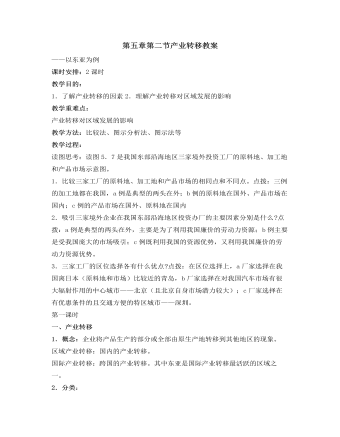
人教版高中地理必修3第五章第二节产业转移教案
1.阅读图5.16,说明产业向国外转移对日本经济的不利影响。点拨:图5.16直观的显示了产业转移对日本经济的不利影响:形成“产业转移出去的多,转移进来的少→国内生产投资不足,生产困难→市场萎缩→产业向外转移,外资不愿进入”的恶性循环。2.尽管重化工业的环境污染比较严重,但是却能为工业化的发展提供坚实的基础,因此成为发达工业的象征。日本、韩国的经济发展都经历了由轻工业(劳动密集型)到重化工业(资源密集型和资金密集型)到高科技工业(技术密集型)的阶段。(1)为什么日本、韩国在重点发展重化工业之前,要先发展劳动密集型工业?点拨:重化工业的发展一方面需要有一定的工业基础和技术工人,另一方面需要投入大量的资金,先发展劳动密集型工业有利于利用劳动力资源丰富且廉价的优势,积累资金和造就产业工人。所以,劳动力丰富的发展中国家或地区的工业化往往从优先发展劳动密集型工业开始。
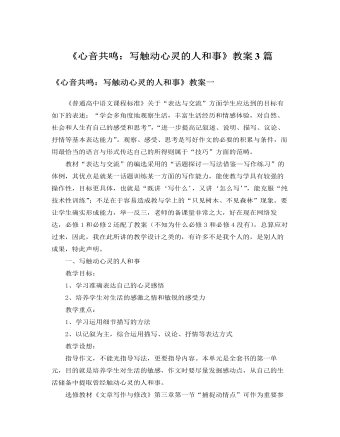
人教版高中语文必修1《心音共鸣:写触动心灵的人和事》教案3篇
《普通高中语文课程标准》关于“表达与交流”方面学生应达到的目标有如下的表述:“学会多角度地观察生活,丰富生活经历和情感体验,对自然、社会和人生有自己的感受和思考”,“进一步提高记叙述、说明、描写、议论、抒情等基本表达能力”。观察、感受、思考是写好作文的必要的积累与条件,而用最恰当的语言与形式传达自己的所得则属于“技巧”方面的范畴。教材“表达与交流”的编选采用的“话题探讨—写法借鉴—写作练习”的体例,其优点是就某一话题训练某一方面的写作能力,能使教与学具有较强的操作性,目标更具体,也就是“既讲‘写什么’,又讲‘怎么写’”,能克服“纯技术性训练”;不足在于容易造成教与学上的“只见树木、不见森林”现象。要让学生确实形成能力,举一反三,老师的备课量非常之大,好在现在网络发达,必修1和必修2还配了教案(不知为什么必修3和必修4没有),总算应对过来,因此,我在此所讲的教学设计之类的,有许多不是我个人的,是别人的成果,特此声明。
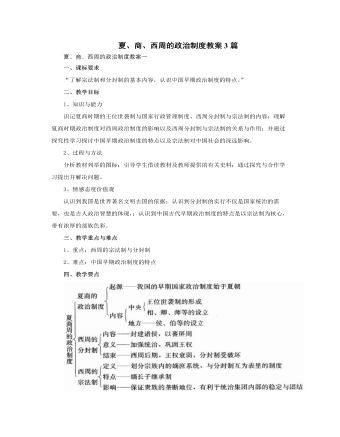
人教版高中历史必修1夏、商、西周的政治制度教案3篇
【大宗与小宗的关系:君臣关系、兄弟关系】4、影响:宗法制保证了贵族在政治上的垄断和特权地位,也有利于统治集团内部的稳定和团结。【合作探究】分封制与宗法制的关系两者互为表里、相辅相成:从根本上说,分封制就是宗法制作用于国家地方政治制度的重要举措和体现。宗法制是分封制的内核和纽带,维护贵族统治集团内部的稳定与团结。宗法制与分封制结合紧密,宗法制是西周政治制度的基础,分封制基于宗法制而产生,与宗法制互为表里。小结:我国早期政治制度(夏商周)发展脉络:起源于夏——初步建立于夏商——完善于西周——瓦解于西周末年到春秋——崩溃于战国★问题解答⊙【学思之窗】从这段记载,你能看出商朝的相权有多大吗?答案提示:相是商朝中央最高官吏,相权很大,包括参定政制、主持政务、辅佐商王等,甚至有时可废立商王。
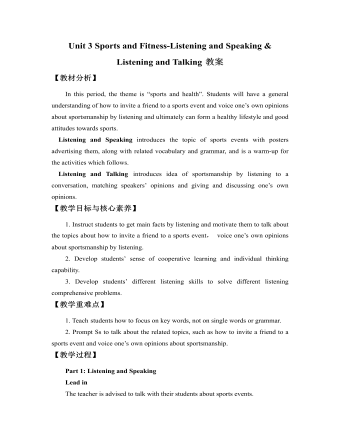
新人教版高中英语必修1Unit 3 Sports and Fitness-Listening and Speaking & Listening and Talking教案
Finally, after finishing the task above, the teacher is expected to instruct students to work in groups to finish the following project:Speaking ProjectWhat event or activity would you like to invite your friend to? Make a conversation with a partner.Ski Race: Zhangjiakou, a beautiful city in northern China, will host the Youth Ski Race in December.Track Meet: a great event for track –and –field lovers on 26 October.Gym Class: come and work out at a gym! You can make it.Part 2: Listening and Talking:The teacher is advised to talk with their new students about the related topic: Boys and girls , what do you think of sportsmanship? Let’s listen and find out:Play the listening and match each opinion with the right speaker. Who do you agree with? Why?Cao Jing _____________ Lily _____________ Max _____________A. An athlete should do his/her best to win.B. The girl should stop and help the other girl. Good sportsmanship is more important than wining!C. An athlete should think about honor and his/her fans if he/she is competing for his/her country.Listen again and circle the expressions that you hear in the conversation.
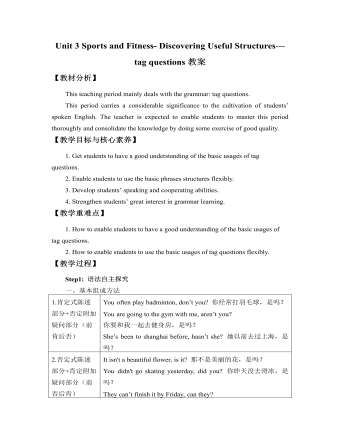
新人教版高中英语必修1Unit 3 Sports and Fitness- Discovering Useful Structures—tag questions教案
【教材分析】This teaching period mainly deals with the grammar: tag questions.This period carries a considerable significance to the cultivation of students’ spoken English. The teacher is expected to enable students to master this period thoroughly and consolidate the knowledge by doing some exercise of good quality.【教学目标与核心素养】1. Get students to have a good understanding of the basic usages of tag questions.2. Enable students to use the basic phrases structures flexibly.3. Develop students’ speaking and cooperating abilities.4. Strengthen students’ great interest in grammar learning.【教学重难点】1. How to enable students to have a good understanding of the basic usages of tag questions.2. How to enable students to use the basic usages of tag questions flexibly.【教学过程】Step1: 语法自主探究一、基本组成方法1.肯定式陈述部分+否定附加疑问部分(前肯后否) You often play badminton, don’t you? 你经常打羽毛球,是吗?You are going to the gym with me, aren’t you?你要和我一起去健身房,是吗?She’s been to shanghai before, hasn’t she? 她以前去过上海,是吗?2.否定式陈述部分+肯定附加疑问部分(前否后肯) It isn't a beautiful flower, is it? 那不是美丽的花,是吗?You didn't go skating yesterday, did you? 你昨天没去滑冰,是吗?They can’t finish it by Friday, can they?他们不能在星期五之前完成,是吗?
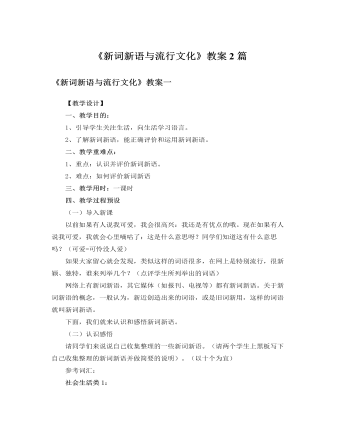
人教版高中语文必修1《新词新语与流行文化》教案2篇
【教学设计】一、教学目的:1、引导学生关注生活,向生活学习语言。2、了解新词新语,能正确评价和运用新词新语。二、教学重难点:1、重点:认识并评价新词新语。2、难点:如何评价新词新语三、教学用时:一课时四、教学过程预设(一)导入新课以前如果有人说我可爱,我会很高兴:我还是有优点的哦。现在如果有人说我可爱,我就会心里嘀咕了:这是什么意思呀?同学们知道这有什么意思吗?(可爱=可怜没人爱)如果大家留心就会发现,类似这样的词语很多,在网上是特别流行,很新颖、独特,谁来列举几个?(点评学生所列举出的词语)网络上有新词新语,其它媒体(如报刊、电视等)都有新词新语。关于新词新语的概念,一般认为,新近创造出来的词语,或是旧词新用,这样的词语就叫新词新语。
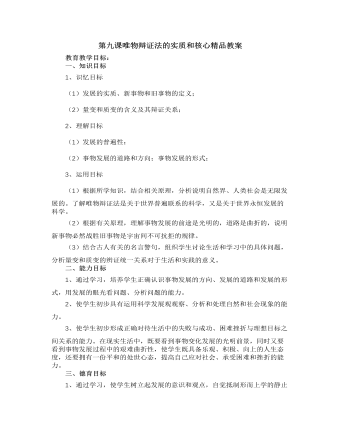
人教版高中政治必修4第九课唯物辩证法的实质和核心精品教案
a矛盾的同一性是矛盾双方相互吸引、相互联结的属性和趋势。它有两方面的含义:一是矛盾双方相互依赖,一方的存在以另一方的存在为前提,双方共处于一个统一体中;同一事物都有对立面和统一面两个方面,一方的存在以另一方为条件,彼此谁都离不开谁(形影想随、一个巴掌拍不响、不是冤家不聚头)。【举例】P67漫画:他敢剪吗?悬挂在山崖上的两个人构成一种动态的平衡。【举例】磁铁(S极和N极);没有上就没有下、没有香就没有臭、没有福就无所谓祸;【举例】父子关系(父亲之所以是父亲,因为有儿子,儿子之所以是儿子,因为有父亲);师生关系;二是矛盾双方相互贯通,即相互渗透、相互包含,在一定条件下可以相互转化。 【相关衔接】P68生物变性现象,雌雄转化现象【举例】生产与消费具有直接统一性





















